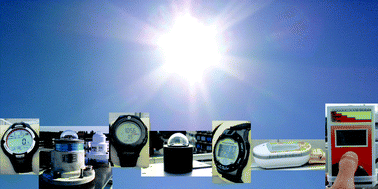Comparison between UV index measurements performed by research-grade and consumer-products instruments
Abstract
Ultraviolet radiation (

- This article is part of the themed collection: Topical and systemic photoprotection
Maintenance work is planned for Wednesday 1st May 2024 from 9:00am to 11:00am (BST).
During this time, the performance of our website may be affected - searches may run slowly and some pages may be temporarily unavailable. If this happens, please try refreshing your web browser or try waiting two to three minutes before trying again.
We apologise for any inconvenience this might cause and thank you for your patience.
a LATMOS–Université Pierre et Marie Curie–Centre National de la Recherche Scientifique, 4 place Jussieu, Paris, France
b
Instituto de Recursos Naturais–Universidade Federal de Itajubá, Av. BPS, 1303–CEP, Itajubá, Brazil
E-mail:
mpcorrea@unifei.edu.br
c Institut Pierre Simon Laplace–École Polytechnique, Palaiseau, France
d Laboratoire d'Optique Atmospherique (LOA)–Université des Sciences et Technologies de Lille, Villeneuve d'Ascq, France
e Research unit EA 4339 “Skin cancer and environment”–Ambroise Paré University Hospital–University of Versailles-Saint Quentin en Yvelines, 9 avenue Charles de Gaulle, Boulogne-Billancourt, France
f Service de Dermatologie–Ambroise Paré University Hospital–Assistance Publqiue-Hôpitaux de Paris, 9 avenue Charles de Gaulle, Boulogne-Billancourt, France
Ultraviolet radiation (

 Please wait while we load your content...
Something went wrong. Try again?
Please wait while we load your content...
Something went wrong. Try again?
M. D. P. Corrêa, S. Godin-Beekmann, M. Haeffelin, C. Brogniez, F. Verschaeve, P. Saiag, A. Pazmiño and E. Mahé, Photochem. Photobiol. Sci., 2010, 9, 459 DOI: 10.1039/B9PP00179D
To request permission to reproduce material from this article, please go to the Copyright Clearance Center request page.
If you are an author contributing to an RSC publication, you do not need to request permission provided correct acknowledgement is given.
If you are the author of this article, you do not need to request permission to reproduce figures and diagrams provided correct acknowledgement is given. If you want to reproduce the whole article in a third-party publication (excluding your thesis/dissertation for which permission is not required) please go to the Copyright Clearance Center request page.
Read more about how to correctly acknowledge RSC content.
 Fetching data from CrossRef.
Fetching data from CrossRef.
This may take some time to load.
Loading related content
